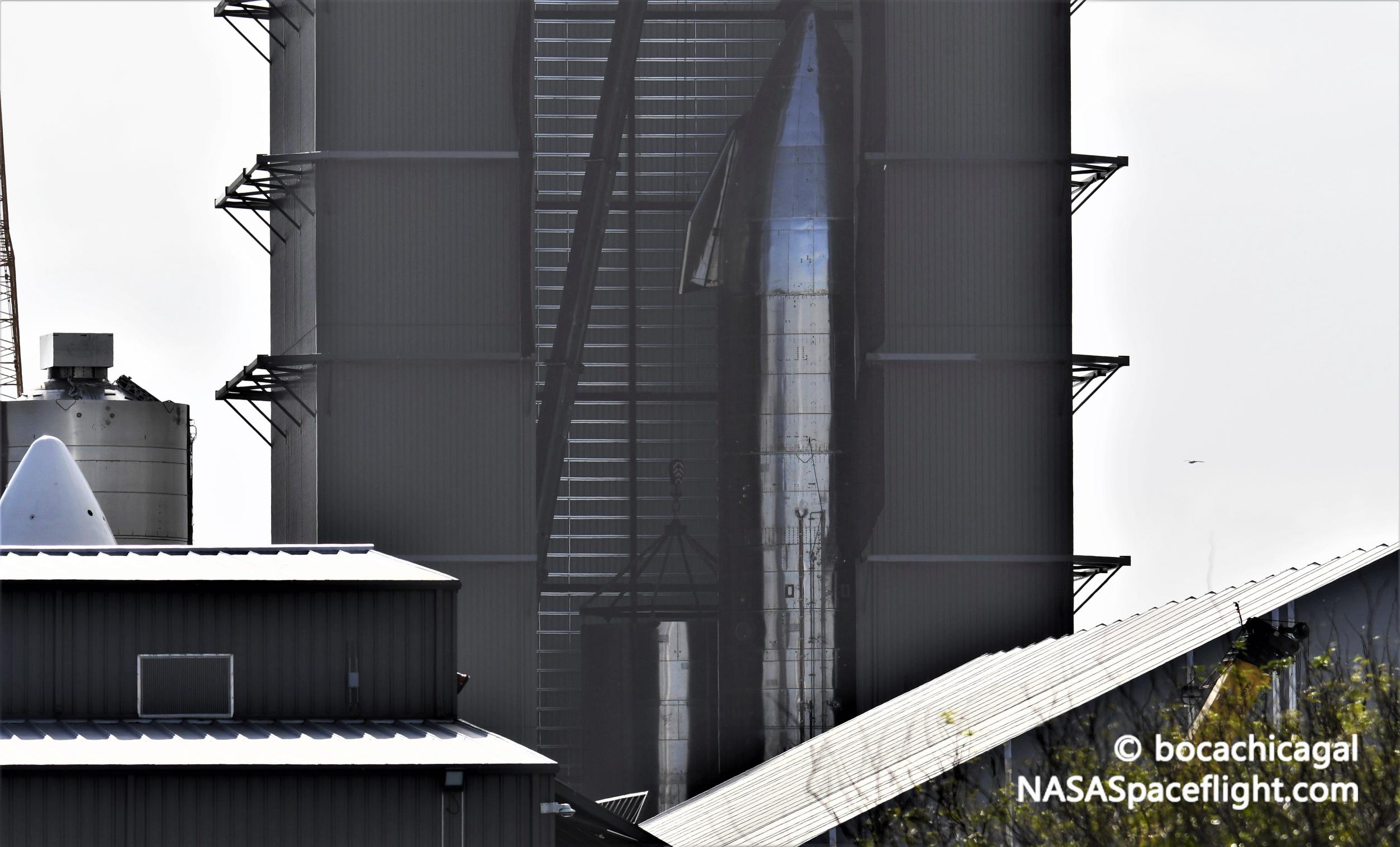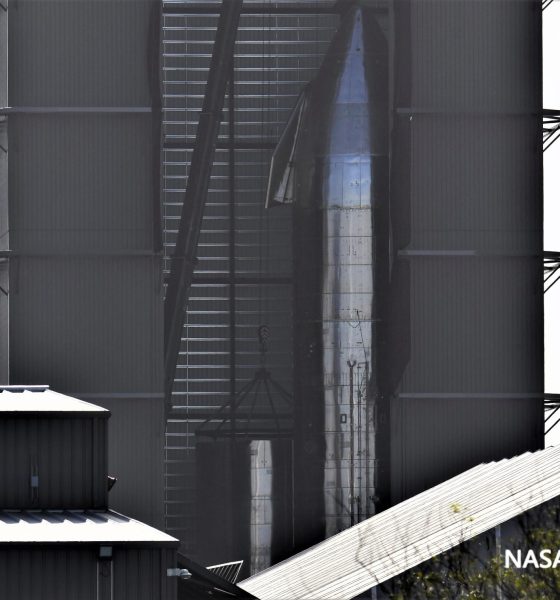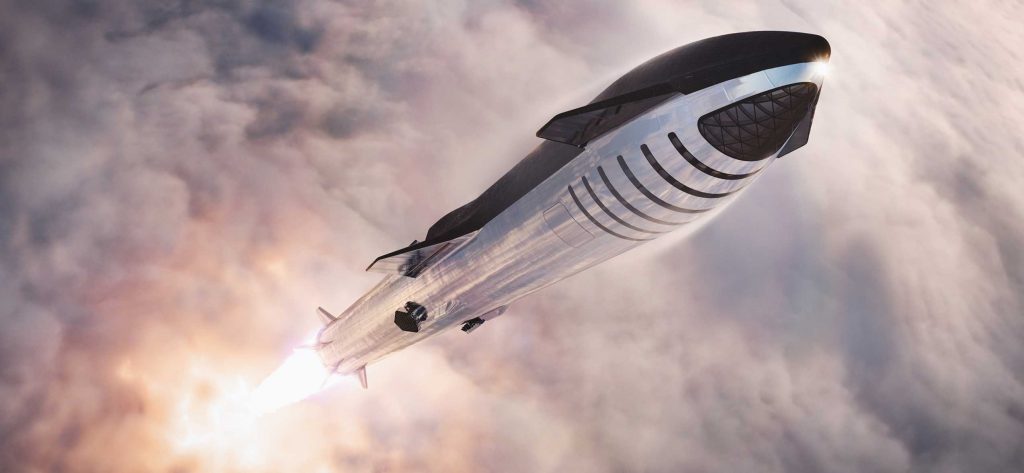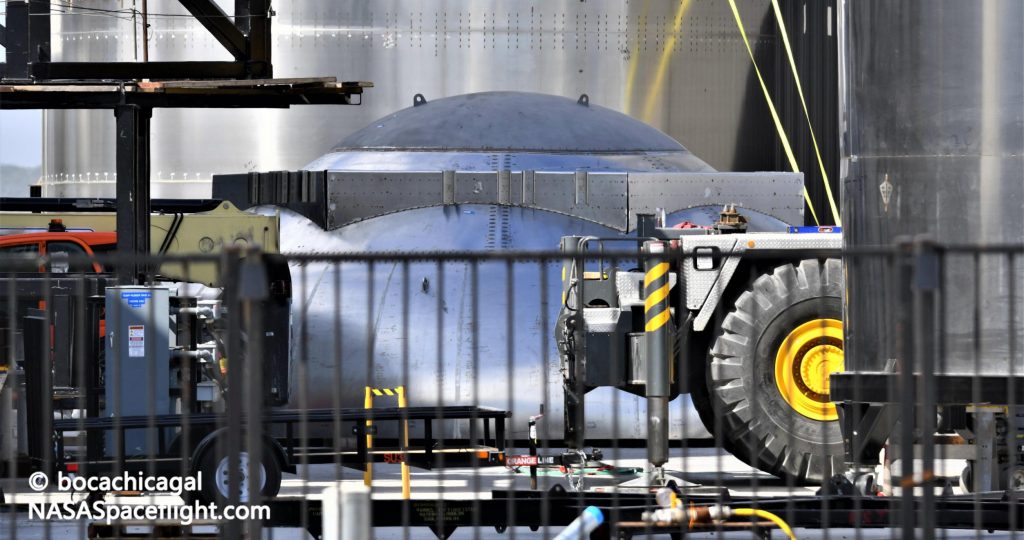

News
SpaceX’s second Super Heavy booster enters production in South Texas
In a rare burst of visible activity, SpaceX’s South Texas Starship factory has begun fabricating a second Super Heavy booster and taken a significant step forward on the first prototype.
Set to be the largest operational rocket stage ever built by more than a factor of two, Super Heavy is the booster tasked with launching a fully fueled and loaded Starship (~1400 mT or 3 million lbs) out of the bulk of Earth’s atmosphere. Powered by up to 28 Raptor engines, Super Heavy and Starship will weigh upwards of 5000 metric tons (~11 million lbs) and produce anywhere from 5600 to 7700 metric tons (12.5-17 million lbf) of thrust at liftoff.
Most importantly, though SpaceX CEO Elon Musk has noted that an optimized Starship might be able to reach orbit on a one-way trip, a giant, reasonably efficient booster like Super Heavy is necessary to send Starship into a healthy orbit with all the extra hardware and mass needed to make the orbital spaceship reusable. More than twice as heavy and two-thirds as tall as SpaceX’s workhorse Falcon 9 rocket, that will be no small feat.

Following the appearance of Super Heavy booster number 1’s (BN1) unique common dome, extra-large ‘transfer tube’ segments, and a donut-like eight-Raptor thrust section last month, visible booster work settled down for the next several weeks. In the interim, Musk revealed that SpaceX aims to hop the first Super Heavy booster (BN1) just “a few months” into 2021, followed by the bombshell that the CEO wants to eventually catch Super Heavy boosters to avoid the need for landing legs entirely.

Two weeks after that latest info from Musk and a month after major booster-related factory activity, the first hardware intended for Super Heavy prototype BN2 was spotted on January 19th. Featuring a never-before-seen structural addition in the form of what looks like a hexagonal or octagonal steel ring, the booster’s unique forward dome represents the first real evidence of the modifications needed to install a variety of hardware specific to Super Heavy.
The limited nature and number of current views make it hard to conclude with certainty that the BN2 forward dome’s add-on is hexagonal or octagonal – either could technically be made to work. Barring a surprise design change, Super Heavy – like Falcon 9 and Heavy boosters – will sport four equally spaced grid fins and use them to ensure aerodynamic stability and control authority from hypersonic to supersonic velocities. Based on official SpaceX graphics, Super Heavy’s grid fins will be built out of welded steel, measure some 7 meters (23 ft) tall, and likely weigh 5+ metric tons apiece, thus requiring extremely powerful actuation systems and strong structural support.

Meanwhile, beyond Super Heavy BN2’s first visible appearance, the process of assembling the first booster prototype also took a significant step forward. Sometime on January 19th, SpaceX ended a long period of inactivity, stacking the first Super Heavy ring sections since November 2020. More specifically, SpaceX teams appear to have installed either one or two four-ring sections on an existing booster segment already inside the high bay.

If at rest on top of the rest of the stack in Mary’s (BocaChicaGal) latest photo, one of two Super Heavy ‘stacks’ inside the high bay is now 12 rings (three sections) tall, representing almost a third of a complete 70-meter (~230 ft) tall booster. As of the most recent look inside the high bay, there were two separate stacks of Super Heavy rings – one with four and the other with eight. Based on the location of the new 12-ring stack, it’s more likely than not that SpaceX has simply combined the 12 rings last seen inside the high bay rather than adding one or two new ring sections to one of the two separate stacks.
Ultimately, the return of Super Heavy stacking activity after a two-month pause is an encouraging sign that SpaceX has settled on a design for the first few prototype boosters and could, in fact, be ready to start testing BN1 “a few months” from now.

Elon Musk
Elon Musk’s X will start using a Tesla-like software update strategy
The initiative seems designed to accelerate updates to the social media platform, while maintaining maximum transparency.

Elon Musk’s social media platform X will adopt a Tesla-esque approach to software updates for its algorithm.
The initiative seems designed to accelerate updates to the social media platform, while maintaining maximum transparency.
X’s updates to its updates
As per Musk in a post on X, the social media company will be making a new algorithm to determine what organic and advertising posts are recommended to users. These updates would then be repeated every four weeks.
“We will make the new 𝕏 algorithm, including all code used to determine what organic and advertising posts are recommended to users, open source in 7 days. This will be repeated every 4 weeks, with comprehensive developer notes, to help you understand what changed,” Musk wrote in his post.
The initiative somewhat mirrors Tesla’s over-the-air update model, where vehicle software is regularly refined and pushed to users with detailed release notes. This should allow users to better understand the details of X’s every update and foster a healthy feedback loop for the social media platform.
xAI and X
X, formerly Twitter, has been acquired by Elon Musk’s artificial intelligence startup, xAI last year. Since then, xAI has seen a rapid rise in valuation. Following the company’s the company’s upsized $20 billion Series E funding round, estimates now suggest that xAI is worth tens about $230 to $235 billion. That’s several times larger than Tesla when Elon Musk received his controversial 2018 CEO Performance Award.
As per xAI, the Series E funding round attracted a diverse group of investors, including Valor Equity Partners, Stepstone Group, Fidelity Management & Research Company, Qatar Investment Authority, MGX, and Baron Capital Group, among others. Strategic partners NVIDIA and Cisco Investments also continued support for building the world’s largest GPU clusters.
News
Tesla FSD Supervised wins MotorTrend’s Best Driver Assistance Award
The decision marks a notable reversal for the publication from prior years, with judges citing major real-world improvements that pushed Tesla’s latest FSD software ahead of every competing ADAS system.

Tesla’s Full Self-Driving (Supervised) system has been named the best driver-assistance technology on the market, earning top honors at the 2026 MotorTrend Best Tech Awards.
The decision marks a notable reversal for the publication from prior years, with judges citing major real-world improvements that pushed Tesla’s latest FSD software ahead of every competing ADAS system. And it wasn’t even close.
MotorTrend reverses course
MotorTrend awarded Tesla FSD (Supervised) its 2026 Best Tech Driver Assistance title after extensive testing of the latest v14 software. The publication acknowledged that it had previously criticized earlier versions of FSD for erratic behavior and near-miss incidents, ultimately favoring rivals such as GM’s Super Cruise in earlier evaluations.
According to MotorTrend, the newest iteration of FSD resolved many of those shortcomings. Testers said v14 showed far smoother behavior in complex urban scenarios, including unprotected left turns, traffic circles, emergency vehicles, and dense city streets. While the system still requires constant driver supervision, judges concluded that no other advanced driver-assistance system currently matches its breadth of capability.
Unlike rival systems that rely on combinations of cameras, radar, lidar, and mapped highways, Tesla’s FSD operates using a camera-only approach and is capable of driving on city streets, rural roads, and freeways. MotorTrend stated that pure utility, the ability to handle nearly all road types, ultimately separated FSD from competitors like Ford BlueCruise, GM Super Cruise, and BMW’s Highway Assistant.
High cost and high capability
MotorTrend also addressed FSD’s pricing, which remains significantly higher than rival systems. Tesla currently charges $8,000 for a one-time purchase or $99 per month for a subscription, compared with far lower upfront and subscription costs from other automakers. The publication noted that the premium is justified given FSD’s unmatched scope and continuous software evolution.
Safety remained a central focus of the evaluation. While testers reported collision-free operation over thousands of miles, they noted ongoing concerns around FSD’s configurable driving modes, including options that allow aggressive driving and speeds beyond posted limits. MotorTrend emphasized that, like all Level 2 systems, FSD still depends on a fully attentive human driver at all times.
Despite those caveats, the publication concluded that Tesla’s rapid software progress fundamentally reshaped the competitive landscape. For drivers seeking the most capable hands-on driver-assistance system available today, MotorTrend concluded Tesla FSD (Supervised) now stands alone at the top.
News
Elon Musk’s Grokipedia surges to 5.6M articles, almost 79% of English Wikipedia
The explosive growth marks a major milestone for the AI-powered online encyclopedia, which was launched by Elon Musk’s xAI just months ago.

Elon Musk’s Grokipedia has grown to an impressive 5,615,201 articles as of today, closing in on 79% of the English Wikipedia’s current total of 7,119,376 articles.
The explosive growth marks a major milestone for the AI-powered online encyclopedia, which was launched by Elon Musk’s xAI just months ago. Needless to say, it would only be a matter of time before Grokipedia exceeds English Wikipedia in sheer volume.
Grokipedia’s rapid growth
xAI’s vision for Grokipedia emphasizes neutrality, while Grok’s reasoning capabilities allow for fast drafting and fact-checking. When Elon Musk announced the initiative in late September 2025, he noted that Grokipedia would be an improvement to Wikipedia because it would be designed to avoid bias.
At the time, Musk noted that Grokipedia “is a necessary step towards the xAI goal of understanding the Universe.”
Grokipedia was launched in late October, and while xAI was careful to list it only as Version 0.1 at the time, the online encyclopedia immediately earned praise. Wikipedia co-founder Larry Sanger highlighted the project’s innovative approach, noting how it leverages AI to fill knowledge gaps and enable rapid updates. Netizens also observed how Grokipedia tends to present articles in a more objective manner compared to Wikipedia, which is edited by humans.
Elon Musk’s ambitious plans
With 5,615,201 total articles, Grokipedia has now grown to almost 79% of English Wikipedia’s article base. This is incredibly quick, though Grokipedia remains text-only for now. xAI, for its part, has now updated the online encyclopedia’s iteration to v0.2.
Elon Musk has shared bold ideas for Grokipedia, including sending a record of the entire knowledge base to space as part of xAI’s mission to preserve and expand human understanding. At some point, Musk stated that Grokipedia will be renamed to Encyclopedia Galactica, and it will be sent to the cosmos.
“When Grokipedia is good enough (long way to go), we will change the name to Encyclopedia Galactica. It will be an open source distillation of all knowledge, including audio, images and video. Join xAI to help build the sci-fi version of the Library of Alexandria!” Musk wrote, adding in a later post that “Copies will be etched in stone and sent to the Moon, Mars and beyond. This time, it will not be lost.”








